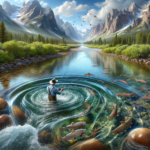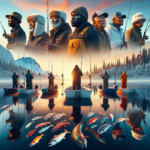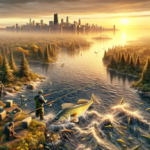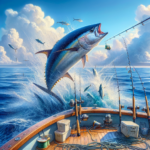Trout Fishing in Wyoming’s Mountain Streams

Introduction
Imagine standing knee-deep in a crystal-clear mountain stream, surrounded by the breathtaking scenery of Wyoming’s rugged wilderness, as you cast your line in hopes of catching a prized trout. Did you know that Wyoming boasts over 27,000 miles of fishable streams and rivers, many of which are teeming with various trout species? This article will guide you through the essentials of trout fishing in Wyoming’s mountain streams, covering everything from the best fishing techniques and gear to the top fishing spots and seasonal considerations.
Whether you’re a seasoned angler or a novice looking to experience the thrill of trout fishing in one of the most picturesque settings in the United States, this guide will provide you with the knowledge and tips you need to make the most of your fishing adventure in Wyoming.
Background/Context
Historical or Cultural Significance
Trout fishing has a rich history in Wyoming, dating back to the early settlers and Native American tribes who relied on the abundant fish populations for sustenance. Over the years, trout fishing has evolved into a popular recreational activity, attracting anglers from all over the world. The state’s commitment to conservation and sustainable fishing practices has helped maintain healthy trout populations, ensuring that future generations can continue to enjoy this cherished pastime.
Geographical Overview
Wyoming’s mountain streams are nestled within the Rocky Mountains, offering a diverse range of fishing environments. The state’s varied topography includes high-altitude alpine streams, lush valleys, and expansive river systems. The climate in these regions can be unpredictable, with cold winters and mild summers, making it essential for anglers to be well-prepared for changing weather conditions. The local ecosystem is home to a variety of wildlife, including deer, elk, and bears, adding to the allure of fishing in this pristine wilderness.
Key Points/Details
Fishing Techniques
Technique Overview
Fly fishing is the most popular technique for trout fishing in Wyoming’s mountain streams. This method involves using a lightweight rod and reel, along with artificial flies that mimic the appearance of insects. Other techniques include spin fishing, which uses a spinning reel and various lures, and bait fishing, which involves using live or artificial bait to attract trout.
When and Where to Use
Fly fishing is particularly effective in fast-moving streams and rivers, where trout are more likely to be feeding on insects. Spin fishing and bait fishing can be used in slower-moving waters or deeper pools where trout may be lurking. The best times to fish are early morning and late evening when trout are most active. Spring and fall are prime seasons for trout fishing, as water temperatures are ideal for trout activity.
Recommended Gear
- Fly Rod: A 9-foot, 5-weight rod is versatile and suitable for most mountain streams.
- Fly Reel: A quality reel with a smooth drag system is essential for handling strong trout.
- Fly Line: Weight-forward floating line is ideal for casting in mountain streams.
- Flies: Dry flies, nymphs, and streamers are all effective patterns for trout fishing.
- Waders: Chest waders with good insulation and waterproofing are crucial for staying dry and comfortable.
- Wading Boots: Boots with felt or rubber soles provide traction on slippery streambeds.
Species Information
Species Overview
Wyoming’s mountain streams are home to several trout species, including rainbow trout, brown trout, brook trout, and the native cutthroat trout. Each species has unique habits and preferred habitats:
- Rainbow Trout: Known for their acrobatic fights, they prefer fast-moving, oxygen-rich waters.
- Brown Trout: Often found in deeper pools and undercut banks, they are more elusive and challenging to catch.
- Brook Trout: Typically inhabit smaller, colder streams and are known for their vibrant colors.
- Cutthroat Trout: Native to the region, they thrive in high-altitude streams and are a prized catch for many anglers.
Best Practices
To successfully catch these trout species, consider the following tips:
- Match the Hatch: Observe the local insect activity and use flies that mimic the prevalent species.
- Stealth and Patience: Trout are easily spooked, so approach the water quietly and make gentle casts.
- Proper Presentation: Ensure your fly or lure drifts naturally with the current to entice trout.
- Adjust Techniques: Vary your retrieval speed and depth to find what works best for the conditions.
Location Information
Top Fishing Spots
Wyoming offers numerous prime fishing locations, including:
- North Platte River: Renowned for its large rainbow and brown trout, with several access points and amenities.
- Snake River: Home to the native Snake River cutthroat trout, offering stunning scenery and excellent fishing opportunities.
- Wind River Range: A remote area with high-altitude streams and lakes teeming with brook and cutthroat trout.
- Yellowstone National Park: Offers diverse fishing environments and the chance to catch native Yellowstone cutthroat trout.
Regulations and Licenses
Before fishing in Wyoming, ensure you have the necessary licenses and are aware of local regulations:
- Fishing License: Required for all anglers aged 14 and older. Licenses can be purchased online or at local retailers.
- Catch Limits: Vary by location and species. Check the Wyoming Game and Fish Department website for specific regulations.
- Seasonal Restrictions: Some areas may have seasonal closures or special regulations to protect spawning trout.
Seasonal Considerations
Seasonal Variations
Fishing conditions in Wyoming’s mountain streams change throughout the year:
- Spring: Snowmelt can cause high, fast-moving water, but also brings increased insect activity and hungry trout.
- Summer: Lower water levels and warmer temperatures can make trout more selective. Fish early morning or late evening for the best results.
- Fall: Cooler temperatures and spawning activity make this a prime time for trout fishing.
- Winter: Fishing can be challenging due to ice and cold weather, but some streams remain fishable year-round.
Best Times to Fish
The optimal times to fish are early morning and late evening when trout are most active. Additionally, overcast days can provide excellent fishing conditions, as trout are more likely to be feeding near the surface.
Events and Tournaments
Event Overview
Wyoming hosts several fishing events and tournaments throughout the year, including:
- Jackson Hole One Fly: A prestigious fly fishing tournament held annually on the Snake River.
- Wyoming Governor’s Cup: A popular fishing competition held on various water bodies across the state.
- Wind River Fly Fishing Classic: An event that attracts anglers to the scenic Wind River Range.
Preparation Tips
To prepare for these events, consider the following tips:
- Practice Casting: Hone your casting skills to ensure accuracy and distance.
- Research the Waters: Familiarize yourself with the fishing locations and conditions.
- Prepare Your Gear: Ensure your equipment is in top condition and pack extra flies, lines, and other essentials.
Tips and Best Practices
General Tips
- Stay Stealthy: Move slowly and quietly to avoid spooking trout.
- Observe the Water: Look for signs of trout activity, such as rising fish or feeding patterns.
- Be Patient: Trout fishing requires patience and persistence. Don’t be discouraged by slow periods.
Avoid Common Mistakes
- Overcasting: Avoid casting too far or too frequently, as this can spook trout.
- Ignoring Local Advice: Listen to local anglers and guides for valuable insights and tips.
- Using the Wrong Gear: Ensure your gear is appropriate for the conditions and species you’re targeting.
Advanced Techniques
- Double Haul Casting: Improve your casting distance and accuracy with this advanced fly fishing technique.
- Euro Nymphing: A highly effective method for catching trout in fast-moving water using weighted nymphs and a tight line.
- Streamer Fishing: Use larger flies that mimic baitfish to target aggressive, predatory trout.
Gear and Equipment Recommendations
Essential Gear
- Fly Rod and Reel: A 9-foot, 5-weight rod and a quality reel with a smooth drag system.
- Fly Line: Weight-forward floating line for versatile casting.
- Flies: A selection of dry flies, nymphs, and streamers.
- Waders and Boots: Chest waders and boots with good traction.
- Polarized Sunglasses: Essential for spotting fish and reducing glare.
Optional Gear/Upgrades
- Wading Staff: Provides extra stability when navigating slippery streambeds.
- Fly Fishing Vest: Keeps your gear organized and easily accessible.
- Net: A landing net with a rubberized mesh to safely handle trout.
Where to Buy or Rent
You can purchase or rent fishing gear from local shops in Wyoming, such as:
- Jack Dennis Fly Fishing Shop: Located in Jackson, offering a wide range of gear and guided trips.
- Wyoming Fly Fishing Guide Service: Based in Casper, providing gear rentals and guided fishing experiences.
- Westbank Anglers: A well-stocked shop in Wilson, offering gear, rentals, and guided trips.
Safety and Conservation
Safety Tips
- Weather Considerations: Be prepared for changing weather conditions and dress in layers.
- Wildlife Hazards: Be aware of local wildlife, including bears, and take necessary precautions.
- Wading Safety: Use a wading staff and move slowly to avoid slipping on slippery rocks.
Conservation Practices
- Catch and Release: Practice catch and release to help maintain healthy fish populations.
- Respect Wildlife: Avoid disturbing local wildlife and their habitats.
- Follow Regulations: Adhere to local fishing regulations and guidelines to ensure sustainable fishing practices.
Planning Your Trip
Accommodations
Consider staying at one of these recommended lodges or hotels near popular fishing spots:
- Snake River Lodge & Spa: Located in Jackson Hole, offering comfortable accommodations and easy access to the Snake River.
- Wind River Hotel & Casino: Situated in Riverton, providing convenient access to the Wind River Range.
- Yellowstone Lodge: A great option for those planning to fish in Yellowstone National Park.
Travel Tips
- Best Routes: Plan your route using major highways and scenic byways for a more enjoyable drive.
- Transportation Considerations: Ensure your vehicle is equipped for mountain driving and carry a spare tire and emergency kit.
Additional Activities
While in Wyoming, consider exploring other activities such as hiking, wildlife watching, and visiting local attractions like Grand Teton National Park and Yellowstone National Park. These activities can make your trip enjoyable for non-anglers in your group as well.
Frequently Asked Questions (FAQs)
Do I need a fishing license to fish in Wyoming?
Yes, a fishing license is required for all anglers aged 14 and older. Licenses can be purchased online or at local retailers.
What is the best time of year to fish for trout in Wyoming?
Spring and fall are prime seasons for trout fishing, with cooler temperatures and increased trout activity. Early morning and late evening are the best times of day to fish.
What gear do I need for fly fishing in Wyoming’s mountain streams?
A 9-foot, 5-weight fly rod, a quality reel with a smooth drag system, weight-forward floating line, a selection of flies, chest waders, and wading boots are essential gear for fly fishing in Wyoming’s mountain streams.
Are there any special regulations or restrictions for fishing in Wyoming?
Yes, regulations vary by location and species. Check the Wyoming Game and Fish Department website for specific regulations, catch limits, and seasonal restrictions.
Conclusion
Trout fishing in Wyoming’s mountain streams offers an unparalleled experience for anglers of all skill levels. With its rich history, diverse ecosystems, and stunning landscapes, Wyoming is a premier destination for trout fishing. By following the tips and recommendations in this guide, you’ll be well-prepared to make the most of your fishing adventure. So pack your gear, obtain your fishing license, and get ready to explore the pristine waters of Wyoming’s mountain streams. Happy fishing!
How to Use This Template:
- For Location-Based Articles: Emphasize sections on “Top Fishing Spots,” “Regulations,” and “Planning Your Trip.”
- For Species-Specific Articles: Focus on “Species Information,” “Techniques,” and “Gear Recommendations.”
- For Technique-Focused Articles: Prioritize “Fishing Techniques,” “Gear and Equipment,” and “Tips and Best Practices.”
- For Seasonal Content: Highlight “Seasonal Considerations” and adjust the “Techniques” and “Gear” sections to suit the season.
- For Event Coverage: Include detailed information in “Events and Tournaments,” along with “Preparation Tips” and “Gear Recommendations.”
Writing Instructions:
- Ensure the article is well-structured and written in a clear, engaging manner.
- Include headings and subheadings for each section to enhance readability.
- Aim for a minimum of 1,500 words, but provide more content if necessary to cover the topic comprehensively.
Formatting Instructions:
- Use
<h2>for main headings. - Use
<h3>for subheadings. - Use
<p>for paragraphs. - Use
<ul>or<ol>for lists. - Use
<strong>for bold text and<em>for italic text where necessary. - Do not include an
<h1>heading since the WordPress theme will automatically create it.




